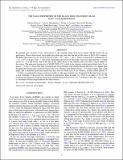| dc.contributor.author | Homan, Jeroen | |
| dc.contributor.author | Fridriksson, Joel K. | |
| dc.contributor.author | Jonker, P. G. | |
| dc.contributor.author | Russell, David M. | |
| dc.contributor.author | Gallo, Elena | |
| dc.contributor.author | Kuulkers, Erik | |
| dc.contributor.author | Rea, Nanda | |
| dc.contributor.author | Altamirano, Diego | |
| dc.date.accessioned | 2015-02-06T16:07:14Z | |
| dc.date.available | 2015-02-06T16:07:14Z | |
| dc.date.issued | 2013-09 | |
| dc.date.submitted | 2013-04 | |
| dc.identifier.issn | 0004-637X | |
| dc.identifier.issn | 1538-4357 | |
| dc.identifier.uri | http://hdl.handle.net/1721.1/93894 | |
| dc.description.abstract | We present new Chandra X-ray observations of the transient black hole X-ray binary MAXI J1659-152 in quiescence. These observations were made more than one year after the end of the source's 2010-2011 outburst. We detect the source at a 0.5-10 keV flux of 2.8(8) × 10[superscript –15] erg s[superscript –1] cm[superscript –2], which corresponds to a luminosity of ~1.2 × 10[superscript 31] (d/6 kpc)[superscript 2] erg s[superscript –1]. This level, while being the lowest at which the source has been detected, is within factors of ~2 of the levels seen at the end of the initial decay of the outburst and soon after a major reflare of the source. The quiescent luminosity of MAXI J1659-152, which is the shortest-orbital-period black hole X-ray binary (~2.4 hr), is lower than that of neutron-star X-ray binaries with similar periods. However, it is higher than the quiescent luminosities found for black hole X-ray binaries with orbital periods ~2-4 times longer. This could imply that a minimum quiescent luminosity may exist for black hole X-ray binaries, around orbital periods of ~5-10 hr, as predicted by binary-evolution models for the mass transfer rate. Compared to the hard state, we see a clear softening of the power-law spectrum in quiescence, from an index of 1.55(4) to an index of 2.5(4). We constrain the luminosity range in which this softening starts to (0.18-6.2) × 10[superscript –5] (d/6 kpc)[superscript 2] (M/8 M ☉) L [subscript Edd], which is consistent with the ranges inferred for other sources. | en_US |
| dc.description.sponsorship | European Commission (Marie Curie Curie Intra-European Fellowship within the 7th European Community Framework Programme, contract No. IEF 274805) | en_US |
| dc.description.sponsorship | United States. National Aeronautics and Space Administration (NASA Chandra award No. GO1-120498) | en_US |
| dc.description.sponsorship | United States. National Aeronautics and Space Administration (NASA Chandra award No. GO2-13061X) | en_US |
| dc.description.sponsorship | United States. National Aeronautics and Space Administration (contract NAS8-03060) | en_US |
| dc.language.iso | en_US | |
| dc.publisher | Institute of Physics/American Astronomical Society | en_US |
| dc.relation.isversionof | http://dx.doi.org/10.1088/0004-637X/775/1/9 | en_US |
| dc.rights | Article is made available in accordance with the publisher's policy and may be subject to US copyright law. Please refer to the publisher's site for terms of use. | en_US |
| dc.source | American Astronomical Society | en_US |
| dc.title | THE X-RAY PROPERTIES OF THE BLACK HOLE TRANSIENT MAXI J1659-152 IN QUIESCENCE | en_US |
| dc.type | Article | en_US |
| dc.identifier.citation | Homan, Jeroen, Joel K. Fridriksson, Peter G. Jonker, David M. Russell, Elena Gallo, Erik Kuulkers, Nanda Rea, and Diego Altamirano. “THE X-RAY PROPERTIES OF THE BLACK HOLE TRANSIENT MAXI J1659-152 IN QUIESCENCE.” The Astrophysical Journal 775, no. 1 (August 28, 2013): 9. ©2013 American Astronomical Society. | en_US |
| dc.contributor.department | MIT Kavli Institute for Astrophysics and Space Research | en_US |
| dc.contributor.mitauthor | Homan, Jeroen | en_US |
| dc.relation.journal | Astrophysical Journal | en_US |
| dc.eprint.version | Final published version | en_US |
| dc.type.uri | http://purl.org/eprint/type/JournalArticle | en_US |
| eprint.status | http://purl.org/eprint/status/PeerReviewed | en_US |
| dspace.orderedauthors | Homan, Jeroen; Fridriksson, Joel K.; Jonker, Peter G.; Russell, David M.; Gallo, Elena; Kuulkers, Erik; Rea, Nanda; Altamirano, Diego | en_US |
| mit.license | PUBLISHER_POLICY | en_US |
| mit.metadata.status | Complete | |
